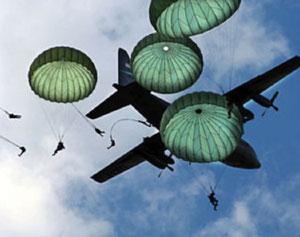
If only Fort Bragg and Pope Army Airfield had the congressional influence that Davis-Monthan Air Force Base in Arizona has. The latter is home to three squadrons of A-10 Thunderbolt jet fighters. The Air Force has been trying to replace the Warthogs, as they are affectionately known, with more modern aircraft. Budget documents from the fiscal 2017 request show the Air Force plans to begin moving out A-10 squadrons in increments between 2018 and 2022 to make room for F-35 squadrons. But Sen. John McCain (R-AZ) is Chairman of the Senate Armed Services Committee and a strong A-10 advocate.
“When the Obama Administration submits its 2017 budget request in the coming weeks, I hope it will follow through on its plan to keep the A-10 flying so that it can continue to protect American troops, many still serving in harm’s way,” McCain said after it was announced the A-10 would survive its “premature” retirement.
Meanwhile, it appears Pope Army Airfield’s C-130 Hercules troop carriers are doomed to relocation. North Carolina’s Congressional delegation has fought the Air Force over the planned deactivation of the 440th Airlift Wing for two years, unsuccessfully. A letter, dated Feb. 4, outlines plans to dismantle the 440th, the Air Force Reserve unit at Pope. Its 700 Reservists are being assigned to other duty stations. The Air Force says aircraft from other bases will be available for Fort Bragg airborne operations and training missions on request.
Army brass, local leaders and members of Congress contend the move will compromise troop readiness, but the news that trickled down this month was not good. Second District Rep. Renee Ellmers (R-NC) said the decision is “beyond disappointing” and “irresponsible to our paratroopers and their readiness.” “The Air Force has unapologetically marched forward with this misguided proposal and shown disdain at the concerns voiced by the N.C. delegation and the Fayetteville community,” she added.
At the same time Sen. Thom Tillis (R-NC) said he found out about the move through third parties instead of the Air Force. “I am surprised and deeply disappointed with the Army’s decision to acquiesce to the Air Force’s strategy for how they will complete training at Fort Bragg,” Tillis said in a statement. In a sharp indictment of the Army’s decision, Tillis added “The burden is on Fort Bragg commanders to demonstrate to Congress and the Fayetteville community that they have not jeopardized the needs of the Global Response Force to placate the reckless desires of budget cutters in the Pentagon.”
Tillis said in his discussions with the former commander of the XVIII Airborne Corps he was told the Air Force withdrawal “would negatively affect their flexibility, and will likely threaten their ability to provide the training needed to complete their mission.” There is no continuity of command at Fort Bragg because the three-star command turns over its leaders every two years. Tillis was clearly frustrated and angry. “For as long as I am a U.S. Senator, the Air Force can fully expect me to require that they demonstrate, on a monthly basis, how they are meeting their obligation to provide assets at Pope Airfield and fulfilling the training requirements of our brave men and women.”
While Tillis and Ellmers have championed Pope Field’s cause by themselves, McCain has had the help of influential Senators Lindsey Graham (R-SC) and Kelly Ayotte (R-NH). “If there were any lingering doubts about the continued value and effectiveness of the A-10, one only need to look to Syria where the A-10 is taking the fight to ISIS,” Sen. Ayotte said in October.
Pope Field’s fate was written in 2005 when the Congressional Base Realignment and Closure Act converted what was Pope Air Force Base to an Army airfield. At the time of the changeover, Col. John Stokes, 440th Airlift Wing Vice Commander said “Throughout all of the transition, the 440th Airlift Wing will continue to provide total force mission ready combat airlifters and equipment, anywhere and anytime.” “The transfer of Pope Field to Army control is certainly an emotional event for our Air Force brethren, but it would be hard to find a closer relationship between sister services than Fort Bragg has had with Pope Air Force Base,” said then Fort Bragg Garrison Commander Col. Stephen Sicinski. The changes that the Bragg-Pope community will notice will be minor, Sicinski insisted.

 How to resolve AdBlock issue?
How to resolve AdBlock issue? 








